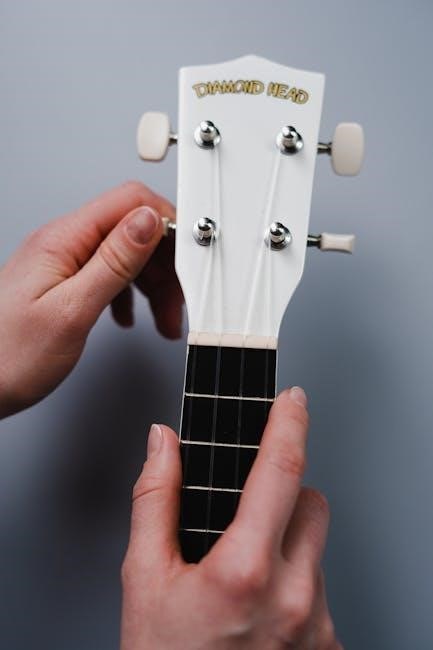Guitar scales are essential for beginners to understand melody and improvisation. They provide a framework for creating music and improving technique. Downloadable PDF guides offer structured lessons and exercises to master scales efficiently, making practice organized and effective for newcomers to guitar playing.
1.1 What Are Guitar Scales?
Guitar scales are a series of notes arranged in a specific order, creating a musical structure. They are fundamental to music theory and playing the guitar, helping musicians create melodies, solos, and riffs. Scales can be major, minor, pentatonic, or blues, each with unique sounds and emotional expressions. For beginners, understanding scales builds finger strength, improves technique, and enhances musical understanding. Downloadable PDF guides often include scale diagrams, exercises, and lessons tailored for newcomers, making learning scales accessible and organized. These resources provide a clear path to mastering scales and applying them in real music.
1.2 Why Learning Scales Is Important for Beginners
Learning guitar scales is crucial for beginners as it builds a strong musical foundation. Scales improve finger strength, dexterity, and coordination, while enhancing understanding of music theory. They also expand creativity, enabling players to improvise and compose. Scales help in recognizing patterns across the fretboard, making playing more intuitive. Additionally, they provide a framework for learning more complex techniques later. PDF guides for beginners often include scale exercises and charts, offering a structured approach to mastering these essential skills. By focusing on scales, new guitarists can develop a solid technique and musical expression from the start.

Choosing the Right Scales for Beginners
Starting with basic scales like the pentatonic and major scales is ideal for beginners. These scales are simple and versatile, providing a solid foundation. PDF guides often highlight these scales, offering clear diagrams and exercises to aid learning and practice, ensuring a smooth progression for new players.
2.1 Top 5 Beginner-Friendly Guitar Scales
For beginners, starting with simple and widely used scales is key. The A Minor Pentatonic, C Major, G Major, E Minor, and D Major scales are highly recommended. These scales are fundamental and versatile, often used in various music genres. They provide a solid foundation for understanding melody and harmony. PDF guides typically include these scales, offering clear diagrams and exercises to help learners master them. Practicing these scales improves finger dexterity and builds a strong musical understanding, making them essential for every beginner’s journey. They also serve as a gateway to more complex scales later on.
2.2 Understanding the Difference Between Major and Minor Scales
The major and minor scales are foundational in music, with distinct emotional qualities. Major scales often sound bright and uplifting, while minor scales convey a sadder or more introspective tone. The difference lies in their interval structure: major scales follow a specific whole and half-step pattern, while minor scales have a different sequence. For beginners, understanding this distinction helps in recognizing and replicating the mood of songs. PDF guides typically include clear comparisons and exercises to help learners grasp these concepts effectively, making it easier to identify and play scales accurately.

The Major Scale for Beginners
The major scale is a bright, uplifting sequence of notes widely used in music. It serves as the foundation for many genres, including rock and pop. PDF guides often include detailed lessons and exercises to help beginners master the major scale effectively, making it easier to progress in guitar playing.
3.1 What Is the Major Scale?
The major scale is a series of seven notes arranged in a specific whole-whole-half-whole-whole-whole-half step pattern. It is one of the most fundamental scales in music, known for its bright and uplifting sound. The major scale is the basis for many musical compositions and is essential for understanding harmony and melody. Each major scale begins on a root note and follows the interval formula: W-W-H-W-W-W-H. For beginners, learning the major scale helps build finger strength and improves technique. Downloadable PDF guides often include diagrams and exercises to simplify the learning process.
3.2 How to Play the C Major Scale
The C major scale is one of the simplest scales for beginners, as it contains no sharps or flats. To play it on the guitar, start by placing your first finger on the 3rd fret of the A string (note C). Next, play the open B string (C#), followed by the 1st fret of the B string (D). Continue with the 3rd fret of the G string (E), the 2nd fret of the G string (F), the open G string (F#), and finally, the 3rd fret of the high E string (G). PDF guides often provide tablatures and finger placement diagrams to help beginners master this scale effectively.
The Minor Scale for Beginners
The minor scale creates a somber, emotional sound, perfect for expressive playing. It’s essential for improvisation and songwriting. Beginner PDF guides break it down clearly, aiding mastery and application in music.
4.1 Understanding the Natural Minor Scale
The natural minor scale, also known as the Aeolian mode, is a foundational scale in music. It follows the interval pattern of whole, half, whole, whole, half, whole, whole steps. This scale is often associated with a sad or melancholic sound, making it popular in various genres. For beginners, understanding the natural minor scale is crucial as it forms the basis for other scales and modes. PDF guides provide diagrams and exercises to help beginners master the natural minor scale, ensuring proper technique and fingering. Regular practice with these resources enhances musicality and improvisation skills.
4.2 How to Play the A Minor Scale
The A minor scale is a versatile scale that begins on the note A and follows the natural minor pattern: whole, half, whole, whole, half, whole, whole. The notes are A, B, C, D, E, F, G, and back to A. For guitarists, this scale is often played in open positions or movable shapes. Beginner-friendly PDF guides provide clear tablature and fingering charts to help master the A minor scale. Start by practicing slowly, focusing on clean notes and smooth transitions. As you progress, incorporate this scale into melodies or solos, especially in genres like rock, folk, or blues.

Focus on Pentatonic Scales

Pentatonic scales are a fantastic starting point for beginners. They include the A major, A minor, and Mixolydian scales. PDF guides provide clear, structured lessons.
The pentatonic scale is a five-note scale widely used in various music genres. It is simpler than the major or minor scales, making it ideal for beginners. The A major pentatonic, A minor pentatonic, and Mixolydian scales are popular choices. These scales are versatile and often used in rock, blues, and pop music. PDF guides for guitar scales provide detailed fingering charts and exercises to help beginners master the pentatonic scale effectively. Starting with these scales builds a strong foundation for more complex scales later on.
5.2 How to Play the A Minor Pentatonic Scale
The A Minor Pentatonic Scale is a fundamental five-note scale for beginners, consisting of the notes A, C, D, E, and G. It is widely used in rock and blues music. To play it, start on the 5th fret of the low E string (A note) and follow a simple pattern: two frets up, two frets up, one fret up, two frets up, and one fret up. PDF guides often include fingering charts and exercises to help master this scale. Practice slowly with a metronome, focusing on clean notes and smooth transitions between frets.

The Blues Scale for Beginners

The blues scale is essential for adding emotional depth to music. It consists of six notes and is widely used in rock and blues genres. PDF guides often provide tablature and exercises to help beginners master it effectively.
6.1 What Is the Blues Scale?
The Blues scale is a six-note scale that adds emotional depth to music. It typically includes the root, minor third, fourth, flat fifth, fifth, and minor seventh. Originating in African-American music, it’s known for its soulful, expressive sound. This scale is widely used in rock, blues, and jazz genres. For beginners, the Blues scale provides a foundation for improvisation and soloing. PDF guides often include fingering charts and exercises to help learners master it. Understanding the Blues scale can enhance your ability to create authentic, feeling-driven melodies and solos.
6.2 How to Play the Blues Scale in A
The A Blues scale is a popular choice for beginners, consisting of the notes A, C, D, D#/Eb, E, and G. To play it, start on the 5th fret of the 6th string (A string). Use the following frets and strings: 5th fret (6th string), 7th fret (5th string), 9th fret (4th string), 10th fret (3rd string), 12th fret (2nd string), and 14th fret (1st string). Practice ascending and descending to build familiarity. PDF guides often include diagrams and exercises to help master this scale. Regular practice will help you apply it to real music and improvisation.

Practicing Guitar Scales
Consistent practice is key to mastering guitar scales. Start with slow, focused exercises, gradually increasing speed. Use a metronome to improve timing and accuracy. Begin with short segments, then expand. PDF guides often provide structured routines and tips to keep your practice organized and productive.
7.1 Effective Scale Practice Techniques
Effective scale practice involves consistency and structure. Start with slow tempos to build accuracy, then gradually increase speed. Use a metronome to improve timing. Focus on small sections before combining them. Practice scales in different positions to enhance familiarity. Incorporate scales into everyday playing by applying them to simple melodies or improvisation. PDF guides often include exercises and routines tailored for beginners, helping to track progress and maintain motivation. Regular practice, even for short periods, ensures steady improvement and a stronger connection to the instrument.
7.2 Tips for Building Speed and Accuracy
Building speed and accuracy requires focused practice. Start with slow, controlled movements, ensuring each note is clear. Use a metronome to gradually increase tempo. Break scales into smaller segments and practice shifts between positions smoothly. Emphasize proper finger placement and alternate picking for consistency. PDF guides often include drills and exercises designed to enhance dexterity. Avoid sacrificing accuracy for speed; precision should always come first. Incorporate scales into daily routines and track progress to stay motivated and see improvement over time.

Using Scales in Real Music
Guitar scales are key to creating and improvising music. The C major scale, for example, is widely used in rock songs. PDF guides provide exercises to apply scales in real music, helping beginners connect theory with practical songwriting and improvisation.
8.1 How to Apply Scales in Songwriting
Applying guitar scales in songwriting enhances creativity and structure. Start by identifying the key of your song and selecting a scale that matches its mood. For example, the A minor pentatonic scale works well for melancholic melodies, while the C major scale suits uplifting tunes. Experiment with chord progressions and use scales to create solos or fills. Downloadable PDF guides often include exercises that demonstrate how to integrate scales into compositions. Practice consistently to develop your skills and confidence in using scales to craft compelling music.
8.2 Examples of Songs That Use Common Scales
Many popular songs use common guitar scales, making them great study tools. For example, the A minor pentatonic scale is featured in “Sunshine of Your Love” by Cream, while the Mixolydian mode shines in “Sweet Home Chicago”. The A major pentatonic scale is heard in “Twist and Shout” by The Beatles. Analyzing these songs helps beginners understand how scales are applied in real music. Downloadable PDF guides often include tabs and breakdowns of these songs, making it easier to learn and practice scales in a musical context. This approach makes learning engaging and relevant for aspiring guitarists.

Resources for Learning Guitar Scales
Best PDF guides provide structured lessons for beginners, while online tools and apps like Fender Play and Guitar Tricks offer interactive learning experiences to master scales effectively.
9.1 Best PDF Guides for Beginners
Beginners can benefit from high-quality PDF guides that provide structured lessons and exercises. These guides often include diagrams, tabs, and step-by-step instructions to help master guitar scales. Many PDFs focus on essential scales like the A minor pentatonic and C major scale, offering practical exercises to build technique. They also cover music theory basics, making it easier to understand how scales apply to real music. Additionally, these guides are often free or affordable, making them an accessible resource for newcomers to guitar playing. They are ideal for organized, self-paced learning and improvement.
9.2 Recommended Online Tools and Apps
Supplementing PDF guides, online tools and apps are excellent for interactive learning. Apps like Fender Play, Guitar Tricks, and Yousician offer lessons tailored for beginners, focusing on scales and technique. They provide video tutorials, interactive exercises, and progress tracking to keep learners motivated. Additionally, browser-based tools like Scale Generator and Guitar Scale Helper allow users to visualize scales across the fretboard. These resources are ideal for those who prefer digital learning and want to practice scales dynamically. They complement PDF guides by offering a more engaging and immersive way to master guitar scales.
Mastering guitar scales builds a strong musical foundation. With dedication and resources like PDF guides and apps, beginners can progress smoothly. Keep practicing to unlock your full potential.
10.1 Summary of Key Points
Guitar scales are fundamental for building melody and improvisation skills. For beginners, starting with the C major, A minor, and pentatonic scales is crucial. These scales provide a solid foundation for understanding music theory and technique. PDF guides and online tools like Guitar Tricks offer structured lessons, exercises, and visuals to aid learning. Regular practice, focusing on accuracy and speed, is essential for progress. Applying scales in real music, such as in songwriting or covering songs, reinforces their practical use; With consistent effort, beginners can master these scales and expand their musical expression.
10.2 Encouragement to Keep Practicing
Mastering guitar scales takes time and dedication, but the journey is rewarding. Consistent practice, even for short periods daily, leads to progress. Celebrate small milestones, like learning a new scale, to stay motivated. Remember, every great guitarist started as a beginner. Use PDF guides and online tools to stay organized and inspired. Surround yourself with music, watch experienced players, and join communities for support. Keep pushing forward—your hard work will pay off, and you’ll unlock endless creative possibilities on the guitar.

No Responses